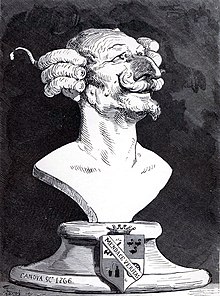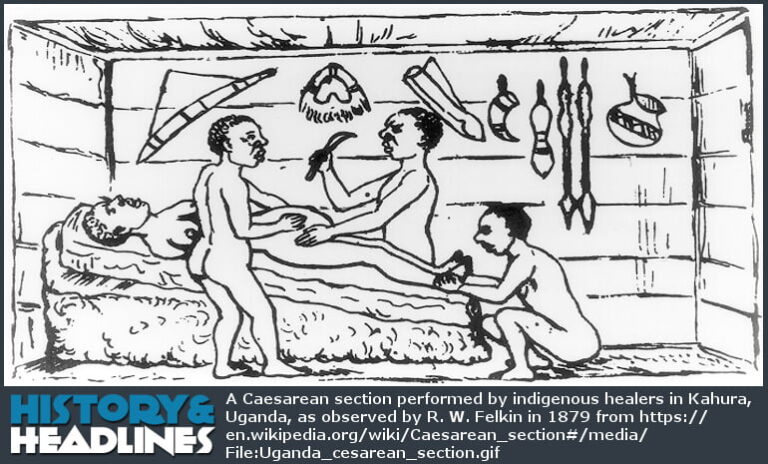A Brief History
On July 13, 100 BC, the world welcomed baby Gaius Julius Caesar into the world, the man the month of July is named after that would become dictator of Rome (but not Emperor; that came after him). Contrary to popular belief, Julius was not delivered by Caesarian Section. Legend has it that it was one of Julius’s ancestors that has that distinction, with the family name “Caesar” stemming from the Latin meaning for C-Section. Here we list 10 instances of medical conditions or procedures named after someone.
Digging Deeper
1. Caesarian Section, unknown Caesar.

The procedure by which a woman’s abdomen is cut open in order to deliver a baby that otherwise could not be safely delivered is supposedly named after an ancestor of Julius Caesar, but not Julius himself. Although practiced for thousands of years, especially when the expectant mother either died or was presumed to die soon, only recently has the practice become commonplace and survivable by the mother. Some ancient cases are said to have resulted in the mother’s survival, but it is likely only the tiniest of percentages of such mothers survived prior to modern medicine. Today, over 23 million of these birthing operations occur each year, taking about 45 minutes to an hour apiece. (Note: The Caesar Salad is named after a guy named Caesar Cardini, 1896-1956, an Italian immigrant to the US.)
2. Heimlich Maneuver, Dr. Henry Heimlich.

An American surgeon and researchers, Heimlich lends his name to a procedure whereby a choking person is administered abdominal thrusts to eject the object being choked on. Publishing his technique in 1974, Heimlich’s advice is believed to have saved the lives of over 50,000 Americans alone since then. (The number saved is offered by Heimlich himself, and is contested.) Dr. Heimlich himself never had the opportunity to use his life saving technique until shortly before he died in 2016, saving the life of a fellow senior citizen (he was 96) living in his senior community. Heimlich died of a heart attack in December of 2016.
3. Wasserman Test, Dr. August Paul von Wasserman.

A German bacteriologist of Jewish heritage, Wasserman developed an antibody test for the venereal disease, Syphilis. Although other tests for this debilitating sexually transmitted disease have been developed, it is likely Wasserman’s test has saved hundreds of thousands of unsuspecting lovers from contracting the disease. Some states (in the US) still require a Syphilis Test prior to being issued a marriage license, and it used to be almost universal. The Wasserman Test is one test you do not have to study for, but you do not want to fail!
4. Lou Gehrig’s Disease, Lou Gehrig.

The immensely popular and immensely talented New York Yankee’s slugger and teammate of Babe Ruth was called “the Iron Man” because of his record of playing the most consecutive major league baseball games in a row (2130) that stood for 56 years (broken by Cal Ripken, Jr.). It seemed this tough guy was invincible, but then he came down with a sore back that turned into a fatal illness, Amyotrophic Lateral Sclerosis (ALS), commonly referred to as “Lou Gehrig’s Disease.” Forced to retire at the age of 35 in 1939, Gehrig was dead at the age of 37 in 1941. Despite his horrible neuromuscular disorder, he famously called himself “The luckiest man on the face of the Earth” at his farewell appearance at Yankee Stadium, a class act to the end. (Note: Possibly the Smartest Man in the World, Stephen Hawking, suffers from this horrible disease.)
5. Alzheimer’s Disease, Alois Alzheimer.

A truly terrifying part about getting old is fear of coming down with Alzheimer’s Disease, a brain rotting fatal neurodegenerative disease that causes the victim to lose memory and thinking functions, bodily functions, and eventually death. German psychiatrist Alois Alzheimer identified the disease in 1901, the first victim being a 50 year old woman. Normally taking 3 to 9 years to kill its victim, the time line of progression can vary immensely between cases. About 60 to 70% of cases of dementia are due to Alzheimer’s. (Note: President Ronald Reagan left office in January of 1989, and the public was told in August of 1994 that he was suffering from Alzheimer’s Disease. Reagan died of the disease in 2004 at the age of 93. Speculation that many of his cognitive gaffes while President may have stemmed from early onset of Alzheimer’s has marred his legacy.)
6. Tommy John Surgery, Tommy John.

With 288 major league victories, John is the 7th highest winning left-handed pitcher in baseball history. Amazingly, more than half those wins came after he had elbow surgery in 1974, interrupting a season in which he had a won-lost record of 13-3. With a severely injured elbow ligament, it seemed the Ace of the Dodgers’ staff was through, but the revolutionary surgery brought him back good as new, and has rehabilitated many athletes and other people since. The technique involves replacing the torn ligament with a tendon from a less vital area of the patient’s body. The rebuilt John went on to a record 26-year major league baseball career (later broken by Nolan Ryan).
7. Munchausen Syndrome, Baron Munchausen.

Alas, the syndrome is real but the “person” it is named after is fictional. Baron Munchausen is a fictional German character created by Rudolph Raspe in 1785, an inveterate liar and exaggerator who tells outrageous lies and tall tales about his adventures and accomplishments. (The character is based on the actual Baron Munchausen, so in a way maybe the syndrome is named after a real person.) Munchausen Syndrome is a psychological problem, where the victim pretends to be suffering from a serious disease or disorder in order to gain sympathy and attention from others. There is even a Munchausen’s Syndrome by Proxy where a mentally ill person fakes an illness on a third party, usually a parent, spouse or cargiver, pretending a child or other person is deathly ill, sometimes even intentionally causing illness or symptoms to better “sell” the lie.
8. Asberger’s Syndrome, Dr. Hans Asberger.

An Austrian pediatrician that studied under Dr. Franz Hamburger, Asberger himself was said to be a lonely and remote child. In 1944 he described a condition in children, a form of autism, whereby the child suffered difficult social interaction and awkward non-verbal communication, sometimes with repetitive behavior and interests. In popular culture, the animated series South Park lampooned this syndrome in 2011 with an episode called “Ass Burgers.” Stan is diagnosed with Asberger’s after his cynical personality is blamed on his recently being vaccinated. Cartman hears the diagnosis as “ass burgers” and goes on to put hamburgers in his butt cheeks, which makes the burgers irresistible to the community, allowing Cartman to sell many of his “Ass burgers” commercially until the secret “ingredient” is found out. (Of course, in South Park fashion, the plot is more complex than this brief description.)
9. Schatzki Ring, Dr. Richard Schatzki.

Dr. Schatzki was a German-Jewish doctor that fled to the United States in 1933 to avoid persecution by the Third Reich. He described a condition (circa 1950’s) in which the lower esophagus is narrowed by a mucosal or muscular interior ring, causing a reduced pathway for food to travel to the stomach. Although sometimes without symptoms, people with this condition often experience difficulty in swallowing and sometimes a total inability to get food past the ring into the stomach.
10. Napoleonic Complex, Napoleon Bonaparte.

As History is written by the victors, the British historians and writers have long slandered Napoleon, Emperor of the French, as being a tiny little guy that attempted to make up for his diminutive stature by overcompensating with aggression and an outsized ego. These writers were wrong about Napoleon’s diminutive size, as at 5’6” he was an average sized man for his day (1769-1821) though he surrounded himself by a personal guard troop that consisted of 6 foot tall soldiers, making him appear shorter than he was. About the outsized ego, well, that could well be true, as all indications are that he thought rather highly of himself and his “N” monogram can be seen on numerous artifacts. Napoleon saw himself as one of the Great Men of History, and he is probably right, considering that more has been written about Napoleon Bonaparte than any other person ever, except Jesus Christ, and even Napoleon did not claim to be divine.
Question for students (and subscribers): What conditions or procedures would you add to the list? Please let us know in the comments section below this article.
If you liked this article and would like to receive notification of new articles, please feel welcome to subscribe to History and Headlines by liking us on Facebook and becoming one of our patrons!
Your readership is much appreciated!
Historical Evidence
For more information, please see…
Baskett, Thomas and Ronald Cyr. Caesarean Birth: The Work of François Rousset in Renaissance France – A New Treatise on Hysterotomotokie or Caesarian Childbirth. Cambridge University Press, 2010.
The featured image in this article, a drawing of a a caesarean section performed by indigenous healers in Kahura, Uganda, as observed by medical missionary Robert William Felkin in 1879, is a work of the National Institutes of Health, part of the United States Department of Health and Human Services. As a work of the U.S. federal government, the image is in the public domain.


